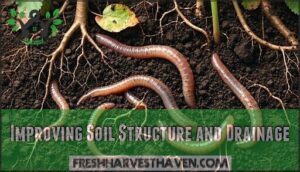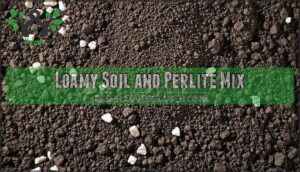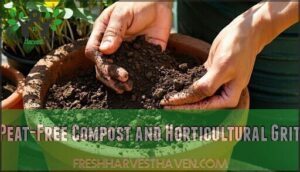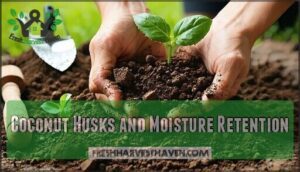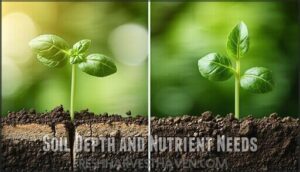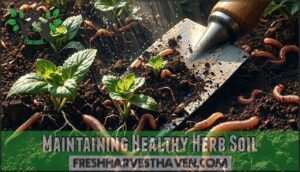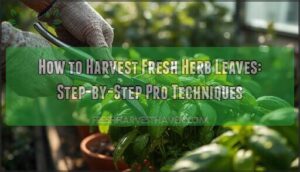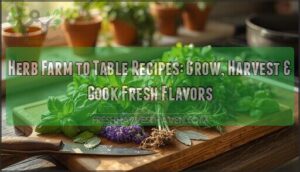This site is supported by our readers. We may earn a commission, at no cost to you, if you purchase through links.
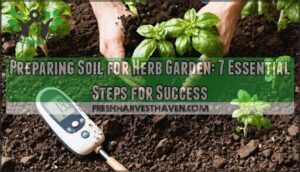
Create proper soil depth by digging 12 inches deep, then add 2-3 inches of organic mulch around plants while keeping it away from stems. This foundation work transforms ordinary dirt into an herb paradise that’ll keep your kitchen stocked with aromatic treasures year-round.
Table Of Contents
- Key Takeaways
- Soil Requirements Overview
- Preparing Herb Garden Soil
- Choosing Right Soil Mix
- Soil Depth and Nutrient Needs
- Maintaining Healthy Herb Soil
- Frequently Asked Questions (FAQs)
- How do you prepare soil for herbs?
- How do you prepare a garden bed for herbs?
- Which herbs should not be planted together?
- What type of soil is best for herbs?
- Can herbs grow in containers year-round indoors?
- What common soil pests affect herb gardens?
- How often should herb garden soil be replaced?
- Which herbs are best for clay soil?
- When is the ideal time to plant herbs?
- Can herbs grow in containers or pots?
- Conclusion
Key Takeaways
- Test your soil’s pH between 6.0-7.0 using digital meters or test strips—this creates the foundation for nutrient uptake and determines what amendments you’ll need before planting.
- Improve drainage by adding organic matter like compost, aged manure, or perlite to ensure water drains at 2 inches per hour, preventing root rot that kills herbs faster than drought.
- Mix in balanced fertilizers with an 8-3-5 NPK ratio at half the recommended rate to provide steady nutrition without overwhelming delicate herb roots with nutrient burn.
- Create proper soil depth of 12 inches and apply 2-3 inches of organic mulch around plants while keeping it away from stems to maintain moisture and suppress weeds.
Soil Requirements Overview
You’ll need to understand your soil’s specific conditions before planting any herbs. Testing your soil’s pH, drainage rate, and nutrient levels creates the foundation for a thriving herb garden that produces flavorful harvests.
Soil PH Requirements
Soil pH acts as the gatekeeper for your herb garden’s success. Most culinary herbs prefer neutral pH levels between 6.0 and 7.0, where nutrient uptake peaks. Testing soil pH levels helps you understand what adjustments you’ll need before planting.
Unlock your herb garden’s full potential—start with pH testing to create the perfect foundation for flavorful harvests
Different herbs have specific preferences for acidic or alkaline soil:
- Basil: thrives in slightly acidic soil (6.2-6.8)
- Mediterranean herbs like rosemary tolerate alkaline conditions (7.0-7.5)
- Parsley and cilantro: prefer neutral pH (6.5-7.0)
- Thyme and oregano: flourish in neutral range (6.0-7.0)
- Acid-loving herbs like blueberry require pH below 6.5
pH testing methods include digital meters or simple test strips. When amending high pH, add sulfur or organic matter. Remember, pH impact nutrients substantially—optimal pH levels guarantee your herbs access essential minerals for healthy growth.
Organic Matter Needs
Your herb garden thrives when you add organic matter that feeds soil microbes and creates humus. Compost benefits include slow nutrient release and improved structure. Adding organic matter like aged manure provides quick nutrients, while leaf mold offers long-term conditioning. These amendments support nutrient cycling, creating the foundation your herbs need.
Amendment Type Decomposition Rates Primary Benefits
Drainage and Water Requirements
Water drainage makes the difference between thriving herbs and dead roots. Test your soil drainage by digging a twelve-inch hole and filling it with water—proper drainage conditions allow two inches to drain hourly. Clay soils need amendments like compost to improve drainage, while sandy soils require organic matter for soil moisture retention.
Watch for overwatering signs like yellowing leaves or soggy roots. Herb-specific needs vary: Mediterranean herbs prefer drier conditions than moisture-loving basil. Consider drainage solutions like raised beds for problematic areas, grouping plants by watering frequency for easier maintenance.
Adding amendments like biochar and humic acid can boost microbial activity in your soil.
Preparing Herb Garden Soil
You’ll transform your herb garden’s potential by properly preparing the soil foundation. Start by testing your soil’s pH and drainage rate, then amend it with organic matter to create the ideal growing environment for thriving herbs.
Improving Soil Structure and Drainage
Poor drainage can turn your herb garden dreams into a soggy nightmare. Test drainage conditions by digging a 12-inch hole and filling it with water—well-draining soil should drain 2 inches per hour.
When drainage testing methods reveal problems, you’ll need targeted solutions:
- Clay Soil Fixes: Add fine pine bark or coarse compost to break up heavy clay
- Sandy Soil Amendments: Mix in coconut husks to improve water retention
- Raised Bed Benefits: Lift planting areas for better drainage and soil temperature impact
- Soil Structure: Regular tilling prevents compaction and maintains aeration
These improvements create the foundation your herbs need to thrive. Many gardeners find success using clay soil amendment.
Adding Organic Matter and Fertilizers
With structure sorted, feeding your soil comes next. Compost types like worm castings and well-aged manure work magic when mixed into the top 8-12 inches. These organic amendments boost drainage while nurturing soil microbes that keep plants healthy.
Apply a balanced organic fertilizer at half the recommended rate—this prevents nutrient deficiencies without overwhelming delicate herbs. Fish emulsion delivers quick liquid nutrition, while granular options provide steady feeding throughout the growing season. A balanced fertilizer with an NPK ratio of 8-3-5 is generally suitable for herbs.
When you amend soil, think layers. Start with organic matter, then add fertilizer. This approach prevents root burn and guarantees even distribution.
Proper fertilizer ratios matter—look for 8-3-5 NPK for vigorous herb growth.
| Amendment Type | Benefits | Application Rate |
|---|---|---|
| Compost | Improves structure, adds nutrients | 2-4 inches mixed in |
| Aged Manure | Rich nitrogen source, moisture retention | 1-2 inches worked in |
| Worm Castings | Gentle nutrients, soil biology boost | 1 inch top-dress |
| Organic Fertilizer | Balanced nutrition, slow release | Half manufacturer rate |
| Fish Emulsion | Quick liquid nutrition | Monthly foliar feed |
Choosing Right Soil Mix
You’ll need the right soil mix to create the perfect growing environment for your herbs. The ideal combination balances drainage, nutrition, and moisture retention to support healthy root development and vigorous plant growth.
Loamy Soil and Perlite Mix
Beyond basic soil preparation, loamy soil and perlite create the perfect foundation for thriving herbs. Mix ratios of 40% sandy-loam soil, 20% perlite, and 30% compost deliver exceptional drainage benefits while supporting strong root development. This loamy soil combination prevents waterlogging that kills Mediterranean herbs like rosemary and thyme.
The perlite benefits include improved aeration and soil structure, while the loam composition provides essential nutrients. Perfect soil texture emerges when drainage properties balance moisture retention, creating ideal growing conditions for your herb garden’s long-term success. A well-draining potting mix is essential for preventing root rot.
Peat-Free Compost and Horticultural Grit
While loamy soil and perlite provide excellent drainage, peat alternatives offer even more sustainable sourcing options for your herb garden soil preparation. Modern peat-free compost uses coir, composted bark, and green waste instead of environmentally damaging peat extraction.
For ideal soil composition, mix three parts coir with one part sieved compost, one part loam, and one part horticultural grit. This combination delivers grit benefits, including better drainage and root health. The mixing ratios create perfect conditions for Mediterranean herbs like rosemary and sage.
Different compost types work well—leaf mold and homemade compost add nutrients without waterlogging. Horticultural grit prevents soggy roots that kill herbs faster than drought.
- Environmental protection – choosing sustainable alternatives preserves precious peat bogs
- Better drainage – grit guarantees your herbs won’t drown in waterlogged soil
- Cost savings – making your own peat-free compost reduces gardening expenses
- Better plant health – improved soil composition promotes stronger herb growth
This sustainable approach gives you healthier plants while protecting natural ecosystems.
Coconut Husks and Moisture Retention
Coconut husks transform your herb garden soil preparation by absorbing 8-10 times their weight in water. These alternative mulches provide exceptional moisture retention without waterlogging roots. Husk decomposition creates air pockets for drainage while slow nutrient release feeds plants.
Smart husk sourcing offers sustainable husk amendments that outperform peat moss for preparing soil for herb garden success. Coco coir offers a neutral pH alternative to peat moss.
Soil Depth and Nutrient Needs
Getting your soil depth and nutrient balance right sets the foundation for thriving herbs that’ll reward you with abundant harvests.
You’ll need to understand how different herbs require varying soil depths and specific nutrient profiles to reach their full potential.
Vegetable and Annual Bedding Flowers
Two types of plants create unique challenges when preparing garden bed soil alongside herbs. Vegetables and annual bedding flowers demand nutrient-rich conditions that differ from herb requirements.
Companion Planting strategies help balance these competing needs:
- Edible Flowers like nasturtiums provide Pollinator Attraction while requiring moderate feeding
- Pest Control plants such as marigolds protect vegetables without depleting herb garden soil
- Seasonal Blooms offer staggered nutrient demands throughout growing periods
- Root vegetables need deeper soil preparation than shallow-rooted herbs
- Annual flowers require consistent moisture unlike drought-tolerant herbs
Organic Fertilizer Application
With your soil depth established, you’ll want to feed your herbs properly. Organic fertilizers work best when mixed into the top 4-6 centimeters of soil before planting. Think of it as setting the dinner table—you’re preparing nutrients your herbs can easily access. Apply these amendments 2-3 weeks before planting to allow proper nutrient release. This timing lets soil nutrients break down and become available when your herbs need them most. Many gardeners find success using specialized herb fertilizers for maximum growth.
Match your organic fertilizer choice to your herbs’ specific nutrient content needs for ideal growth.
- Compost tea and well-rotted manure types: Provide slow-release nutrient ratios that improve soil structure over time
- Bone meal and blood meal: Deliver quick-acting phosphorus and nitrogen for immediate plant response
- Green manure crops: Add organic matter while fixing nitrogen naturally in your garden beds
Planting Depth and Rootball Level
Position your herb transplants so the rootball sits flush with the soil surface. Planting too deep restricts airflow and invites root rot, while shallow planting exposes roots to drying.
Most herbs follow standard seedling depth guidelines, but tomatoes benefit from deeper planting for improved herb support.
Gently firm soil around each transplant, avoiding compaction, then water immediately.
Maintaining Healthy Herb Soil
Once you’ve established the foundation for your herb garden, maintaining healthy soil becomes your ongoing priority for sustained plant health.
Regular care through mulching, temperature management, and proper watering guarantees your herbs continue to flourish throughout the growing season.
Mulching and Moisture Retention
Mulching transforms your herb garden into a self-sustaining ecosystem that works smarter, not harder. Apply 2-3 inches of organic mulch around each plant, leaving space near stems to prevent moisture buildup and pest issues.
Mulch Types deliver these essential benefits:
- Moisture retention – reduces watering needs by 40% through water conservation
- Weed suppression – blocks sunlight from germinating unwanted seeds
- Soil erosion prevention – protects topsoil during heavy rains
- Organic matter breakdown – enriches soil preparation naturally over time
Smart moisture monitoring guarantees your mulched beds stay perfectly balanced.
Soil Temperature and Weed Control
Your garden thermometer reveals when weeds strike and herbs thrive best. Soil Warming Methods like dark mulch raise temperatures for early planting, while Weed Identification helps you spot trouble before it spreads. Apply Herbicide Use when soil reaches 65°F for maximum effectiveness. Solarization Technique using clear plastic kills weed seeds at 120°F. Choose Mulch Types strategically—organic materials maintain steady temperatures while blocking light that weeds need. Implementing companion planting strategies can naturally deter pests.
Regular Watering and Harvesting Tips
With proper temperature control and weed management in place, maintaining watering frequency and harvesting methods becomes your next priority. Your herb garden needs consistent care to stay productive.
Regular watering keeps moist soil conditions that herbs crave. Optimal timing for harvest affects flavor intensity substantially.
- Water deeply twice weekly rather than daily light sprinkles
- Check soil moisture 2 inches down before watering
- Harvest in early morning when oils are concentrated
- Use clean scissors for tool selection and proper cuts
Post-harvest care includes immediate processing or proper storage to maintain freshness.
Frequently Asked Questions (FAQs)
How do you prepare soil for herbs?
Test your soil’s pH first—it’s absolutely essential for herb success! Dig a test hole, check drainage rates, and amend clay soils with compost or pine bark for ideal growing conditions.
How do you prepare a garden bed for herbs?
Clear weeds and debris, then loosen soil with a garden fork. **Test pH levels and drainage rate.
** Add organic matter like compost to improve structure and nutrients for ideal herb growth.
Which herbs should not be planted together?
Avoid planting mint with other herbs since it’s invasive and spreads aggressively. Don’t pair fennel with most herbs as it inhibits their growth through allelopathy.
Keep basil away from rue, which can stunt basil’s development.
What type of soil is best for herbs?
You’ll want well-draining, loamy soil with a pH between 0- Most herbs thrive in light, sandy mixtures that drain about two inches per hour, avoiding heavy clay soils.
Can herbs grow in containers year-round indoors?
Yes, you can successfully grow herbs indoors year-round in containers. Choose sunny windowsills or supplement with grow lights, guarantee proper drainage, and select compact varieties like basil, parsley, chives, and thyme for best results.
What common soil pests affect herb gardens?
You’ll encounter aphids, spider mites, whiteflies, fungus gnats, and cutworms in your herb garden.
These pests damage plant roots, leaves, and stems by feeding, chewing, or cutting through tender seedlings at soil level during nighttime feeding sessions.
How often should herb garden soil be replaced?
Most herb gardens maintain soil health for 3-5 years without replacement. You’ll refresh your garden’s foundation by adding 2-3 inches of compost annually rather than complete soil replacement, keeping your herbs thriving affordably.
Which herbs are best for clay soil?
Mediterranean herbs like rosemary, thyme, oregano, and sage actually thrive in clay soil’s dense structure. These hardy perennials adapt well to clay’s moisture retention and don’t mind the slower drainage that usually challenges other plants.
When is the ideal time to plant herbs?
Timing isn’t just folklore—spring’s soil temperature truly drives herb success. You’ll want to plant most herbs after your last frost date when soil reaches 60°F, usually late spring through early summer for ideal germination and growth.
Can herbs grow in containers or pots?
Yes, you can successfully grow herbs in containers or pots. Choose pots with drainage holes, use well-draining potting mix, and guarantee adequate sunlight for thriving container herb gardens.
Conclusion
Like Goldilocks finding the perfect porridge, preparing soil for herb garden success requires getting everything "just right." You’ve learned that proper pH testing, drainage improvements, and organic matter additions create the foundation your herbs need.
Remember to maintain 6.0-7.0 pH levels, guarantee two-inch-per-hour drainage rates, and apply balanced fertilizers regularly. With consistent mulching and proper depth preparation, you’ll transform ordinary dirt into herb-growing gold that produces aromatic harvests season after season.
- https://extension.oregonstate.edu/news/add-organic-matter-improve-garden-soils
- https://hellogravel.com/what-type-of-compost-is-best-for-an-herb-garden/
- https://www.sciencedirect.com/science/article/pii/S0959652623023065
- https://arboristnow.com/news/the-impact-of-composting-on-soil-health-and-plant-growth/
- https://www.oldcobblersfarm.com/post/organic-herb-fertilizer-guide

